The University of Kashmir, carved out of the erstwhile university of Jammu and Kashmir, after its bifurcation is a state university and as such a state liability. A cursory look at the revenue expenditure reveals the burgeoning salary bill, given the manifold salary increase after the implementation of the fifth pay commission recommendations. 
This was exacerbated by the engagement of unprecedented number of casual engagements during the previous Vice-chancellors’ tenure, a misadventure which the
present VC candidly admitted from day one. The NAAC peer team that visited the institution in July this year, for its re-accreditation highlighted the large ratio of 1:4 in favour of non-teaching staff and as per sources one of the recommendations of the team will be to reduce the ratio to 1:2 till the time of next re-accreditation.
Around one-third of the teaching positions are lying vacant and a sizable portion of teaching workload is shouldered by contractual lecturers, whose salary was reduced to Rs 12000 (for PhD candidates) and Rs 10000 (for M Phil and NET holders) after the last year hike, which was in tune with the UGC norms.
The university owns a huge fleet of vehicles to ferry the administrative officers of various ranks. This is evident from the amount incurred on account of Diesel and other related charges. The institution has around 75 vehicles, out of which only 15 are meant for students. As per reports administrative officers of assistant registrar ranks are provided separate vehicles and a move disliked by the incumbent VC. Vehicles purchased for the research activity like field work, data collection etc are used by Heads of many departments for their personal use.
Fellowships given to research students, meritorious and financially weaker students are only nominal. This could have severe implications for the development of quality research in the institution. A paltry sum of 14 lakhs has been spent on this count. Given the educational backwardness of the state, the fellowships and scholarships should have been much larger. This is in spite of the fact that the social welfare department of the state provides a major portion of the funds distributed among a few needy.
The money from various central funding agencies like UGC, DST etc mainly comes in the form of grants for carrying out research projects in the teaching departments. However only a small percentage of the faculty put in efforts to get their projects funded by these institutions, while majority are complacent with their salaries, a trend that could damage the credibility of the institution in the long run.
For the last several years the institution in a bid to generate self finance has introduced the payment seat quota in the admissions made in various PG and UG courses. The money generated is pooled and a certain portion is provided to the individual teaching departments to meet their infrastructural and academic needs, the rest remains at the disposal of the administration for the development of the institution as a whole.
The university needs to evolve a long term developmental plan and fund allocation should be made accordingly, rather than spent on the whims and instincts of the pseudo-academic administrators of the institution in order to emerge as an academically vibrant centre of excellence.













